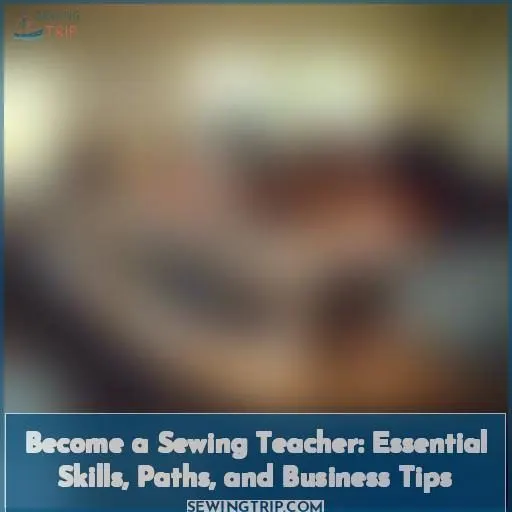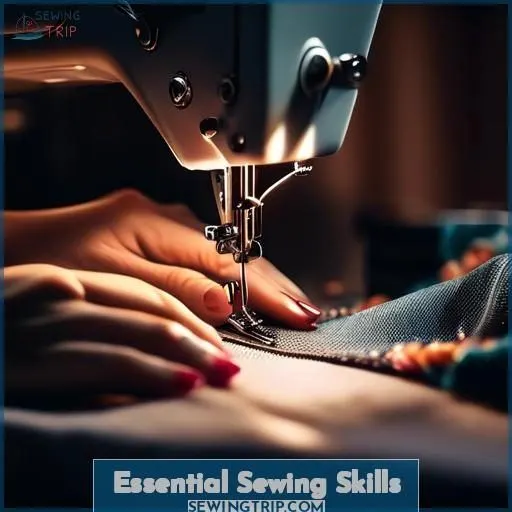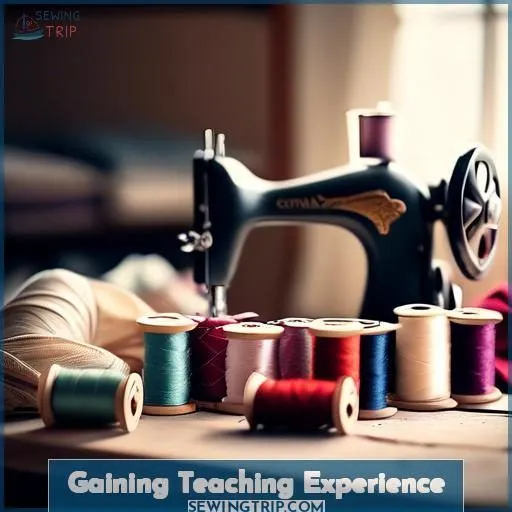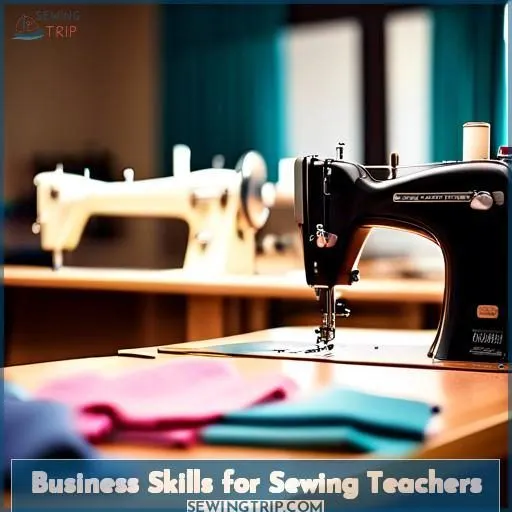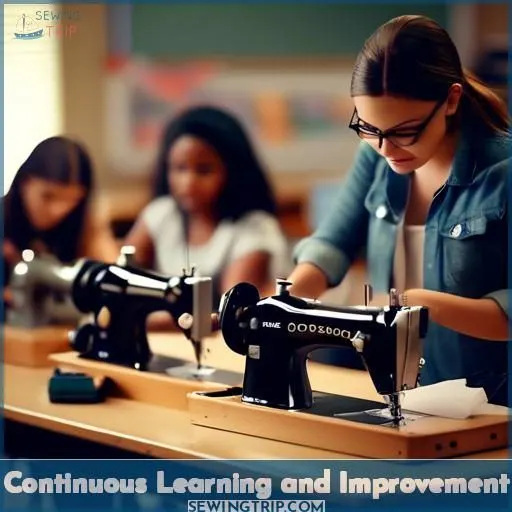This site is supported by our readers. We may earn a commission, at no cost to you, if you purchase through links.
To become a sewing teacher, start by honing your essential skills. Master hand sewing techniques like embroidery and applique, as well as machine sewing proficiency with sergers and pattern adjustments.
Consider pursuing a relevant degree or certification program to build your teaching credentials. When leading workshops, tailor lessons to your audience, keep them engaged, and develop a supportive curriculum covering core sewing skills.
Establish a strong marketing presence, leverage digital tools, and network locally to attract students. Continuous learning is key – stay up-to-date on the latest sewing trends and techniques.
Table Of Contents
Key Takeaways
- Master hand sewing techniques and machine proficiency to effectively teach sewing skills.
- Pursue relevant degree programs or certifications to enhance teaching credentials.
- Develop a supportive curriculum and marketing presence to attract students.
- Continuously learn and stay updated on the latest sewing trends and techniques.
How to Be a Sewing Teacher?
To embark on a path as a sewing instructor, contemplate the following measures:
- Attain a Bachelor’s degree: This initial step in your odyssey to becoming a sewing teacher typically requires four years of academic pursuits.
- Accumulate experience: Subsequent to the completion of your degree, it’s prudent to acquire hands-on experience in sewing or teaching for a minimum of one to two years.
- Undergo on-the-job training: To fully equip yourself for a career as a sewing teacher, it’s advisable to engage in three to six months of practical training within a professional setting.
Moreover, if you’re a novice in the craft of sewing, you may find it beneficial to enroll in a course dedicated to the operation of a sewing machine. This can provide you with a solid foundation in the fundamentals and bolster your confidence before undertaking the task of instructing others.
Essential Sewing Skills
To be an effective sewing teacher, you’ll need strong hand sewing techniques and proficient skills on the sewing machine. Mastering these essential sewing skills will allow you to demonstrate techniques confidently and provide thorough guidance to your students.
Hand Sewing Techniques
Hand sewing is a foundational skill for any aspiring sewing instructor. It encompasses various techniques such as embroidery, smocking, quilting, applique, and beading. These skills are vital for crafting unique and intricate designs on fabric, which enhances the value of your sewing lessons. When teaching hand sewing, it’s imperative to offer a variety of fabric selection options, as different materials can greatly affect the ease of sewing. For beginners, consider using felt, known for its straightforward structure and diverse color options.
To guarantee a successful hand sewing class, follow these tips:
- Choose a pattern: Select a simple pattern that requires a limited number of stitches and can be completed in one session, such as a finger puppet or a needle book.
- Prepare materials: Gather all necessary supplies, including thread, needles, scissors, pins, and fabric. Ensure you have a sample ready to display the stitches and patterns.
- Foster creativity: Allow students to express their creativity by selecting their own colors and patterns.
- Start with basic stitches: Begin with simple stitches like the running stitch and gradually introduce more intricate ones.
- Provide guidance: Offer assistance and guidance throughout the sewing process to ensure students are making progress and learning effectively.
As a sewing instructor, you’ll also need to develop your own hand sewing skills to demonstrate and guide your students. Practice different hand sewing techniques regularly to improve your proficiency and confidence in teaching these skills.
Machine Sewing Proficiency
To become an effective sewing teacher, it’s imperative to master machine sewing techniques. Here are four indispensable skills to prioritize:
- Machine proficiency: Familiarize yourself with different sewing machines, including sergers, which are designed to provide a polished finish for both woven and knit fabrics. Sergers can be used for a multitude of seam finishes, such as zig-zag, French seam, turned under edges, overedge stitch, pinking, and bias bound edges.
- Fabric knowledge: Comprehend the characteristics of various fabrics and how they behave when sewn. This understanding will assist you in guiding your students in selecting the appropriate fabric for their projects and guaranteeing that they attain the desired outcomes.
- Problem-solving techniques: Be prepared to assist your students in navigating common sewing machine issues, such as thread breakage, skipped stitches, and seam puckering. Familiarize yourself with the troubleshooting guides provided by sewing machine manufacturers and retailers.
- Pattern adjustment and seam finishing: Instruct your students how to adjust patterns to accommodate different body sizes and sew seam finishes that prevent fraying and enhance the aesthetics of their projects.
Educational Pathways
If you’re interested in embarking on a career as a sewing teacher, you have a few possibilities to contemplate. You can pursue a relevant degree program or explore certification options to acquire the indispensable teaching abilities and knowledge.
Relevant Degree Programs
As a sewing teacher, you’ll need a solid grounding in both hand and machine sewing techniques. Applicable coursework may encompass teaching methodologies, curriculum development, student evaluation, classroom administration, and lesson planning. To augment your abilities, consider pursuing a degree in fashion design, home economics, or textiles. A degree can also furnish professional practice and equip you for professional certification or a teaching credential.
Sewing instruction is essential for a prosperous career as a sewing teacher.
Certification Options
To become a certified sewing instructor, there are several options available to you. One popular choice is the Palmer/Pletsch Teacher Training Classes, which offer seminars and workshops to help you develop your sewing skills and teaching techniques. These classes cover a range of topics, from 20 Sewing Tips to Looking Good and Perfect Fusing. Additionally, Palmer/Pletsch offers a Teacher’s Update Newsletter, which provides news and resources for teachers to share and learn from each other.
Another option is to become a certified instructor through the Association of Sewing and Design Professionals (ASDP). This involves taking workshops such as Fit, Pant Fitting & Sewing, Tailoring, Master Your Serger at Home, or Beginning Fashion Sewing Teacher Training. After completing these workshops, you can apply to become a Palmer/Pletsch Certified Sewing Instructor, which allows you to promote yourself as a certified teacher and potentially attract more students.
In terms of resources, there are various options available to help you in your teaching journey. For example, the Kids Can Sew Program provides a student curriculum with teacher guides and resources, allowing you to teach children, teens, and adults effectively. Additionally, Lesson Planet offers a range of sewing lesson plans and worksheets for various skill levels, from basic projects to advanced quilting lessons.
Finally, it’s crucial to remain abreast of sewing trends and techniques. Sewing newsletters, such as Paperbag Waist, The Sewing Machine Newsletter, and Studio Memoir, can provide valuable insights and inspiration for your teaching. These newsletters often include Q&As, sewing tips, and pattern announcements, helping you to refine your skills and stay informed about the latest developments in the sewing world.
Gaining Teaching Experience
Are you ready to share your sewing expertise with others? Starting a sewing workshop is an excellent way to gain teaching experience. Develop a curriculum that covers essential sewing skills and caters to your students’ needs, and you’ll be on your way to becoming a successful sewing instructor.
Workshop Formats
Diving into workshop planning, remember that a well-structured class is the backbone of your success. It’s not just about threading needles; it’s about weaving experiences that stitch together knowledge and fun.
- Tailor your lesson preparation to your audience, ensuring each class fits like a glove.
- Keep audience engagement high with interactive tasks; think of it as the fabric of learning.
- Consider diverse pricing models, from community center rates to premium private sessions.
Curriculum Development
As a sewing teacher, you’ll be accountable for crafting intriguing and efficient lesson blueprints to aid your students in mastering the craft of sewing. Here are some crucial perspectives to ponder when shaping your program:
- Lesson planning: Begin by sketching the abilities you desire your students to acquire and the undertakings they’ll tackle. Fragment each undertaking into manageable measures, and assign ample time for each skill.
- Teaching materials: Gather all the requisite materials for your classes, such as textiles, threads, needles, and sewing machines. Be sure to have a range of materials to accommodate varying skill levels and predilections.
- Student assessment: Regularly evaluate your students’ progression to discern areas where they necessitate enhancement and to adjust your teaching approaches accordingly. This can be accomplished through quizzes, projects, or practical assessments.
- Class management: Establish perspicuous rules and anticipations for your classroom, such as appropriate use of sewing machines and secure handling of sharp instruments. Foster a supportive and cooperative learning milieu.
- Classroom environment: Make certain that your classroom is adequately ventilated, well-lit, and capacious enough for students to work comfortably. Ensure all sewing machines are in satisfactory working order and that students have sufficient space to maneuver.
Business Skills for Sewing Teachers
As a sewing teacher, effective marketing and advertising are indispensable to luring students and expanding your business. Contemplate presenting introductory workshops at reasonable prices to construct a steadfast customer base and establish your reputation as an adept and well-informed instructor.
Marketing and Advertising
As a sewing instructor, promoting your expertise and offerings is vital to engage learners and expand your enterprise. Initiate by establishing a robust social media presence, highlighting your creations, and fostering connections with your audience. Leverage digital marketing tools and platforms to reach a broader audience.
Consider joining local networking events and workshops to establish contacts with prospective learners in your locality. Email marketing and creating valuable content can also facilitate the development of a devoted following and effectively promote your classes.
Pricing Strategies
As a sewing teacher, establishing the appropriate pricing model is essential for the prosperity of your business. Here are four strategies to assist you in ascertaining your pricing:
- Hourly rates: Determine the amount you’ll charge per hour of instruction. Contemplate your experience, abilities, and the time invested in preparing materials and lessons.
- Flat fees: Proffer workshops or classes with a predetermined price, irrespective of the number of participants. This may be more advantageous for your students and enables you to plan your schedule more efficiently.
- Group discounts: Incentivize group bookings by offering price reductions for multiple individuals. This can aid in attracting a greater number of students and boosting your revenue.
- Session bundles: Provide discounted packages of several sessions or workshops. This can entice students to reserve more sessions and provide a more stable income stream for your business.
Continuous Learning and Improvement
Don’t stop learning once you become a sewing teacher. Invest in advanced sewing courses and join professional networks to continuously improve your skills and knowledge.
Advanced Sewing Courses
To truly master the art of sewing, consider enrolling in advanced courses that explore specialized techniques. These courses will not merely improve your skills but also expand your teaching repertoire.
By continuously learning and broadening your knowledge, you’ll be able to inspire and guide your students in their pursuit of sewing mastery. The specialized techniques include advanced fabric treatments, pattern drafting, embellishment methods, couture sewing, and fabric manipulation.
Joining Professional Networks
Diving into sewing guilds and industry events can stitch you into the fabric of the sewing community. Online communities are a treasure trove of patterns and wisdom, offering mentorship programs that can hem in knowledge gaps.
Seize these networking opportunities to tailor your teaching prowess. Remember, even the most seasoned stitchers need a pattern pal to keep their skills sharp and on point.
Frequently Asked Questions (FAQs)
How do I market my sewing classes to attract students?
Crafty souls, release your sewing magic! Entice students with irresistible promotions: dazzling discounts, tantalizing freebies, and inviting studio tours. Showcase your expertise, spark their creativity, and watch your classes fill up faster than a bobbin!
What are the best materials to use for teaching sewing to beginners?
For beginning sewers, start with cotton fabric – it’s durable, affordable, and easy to work with. Opt for simple projects like tote bags or pillows to build skills. Avoid slippery fabrics until you’ve mastered the basics.
How can I create a curriculum that covers essential sewing skills for different age groups?
Crafting a sewing curriculum is like tailoring a garment – it takes an eye for detail and a touch of creativity. Start with the basics, then build layers of skills like a fine-tuned machine. Your students will sew their way to confidence in no time!
What are some effective strategies for troubleshooting common sewing machine issues in the classroom?
When troubleshooting sewing machine issues, stay calm and methodical. Check the basics first – threadsettings, tension, presser foot. Walk students through step-by-step fixes, and encourage troubleshooting as a collaborative process. A little patience goes a long way!
How can I create a supportive and inclusive learning environment for students with diverse backgrounds and abilities?
Nurturing a thriving sewing sanctuary requires adjusting your teaching approach – a customized approach that embraces their individuality. Understanding and motivation unleash their sewing brilliance, forging a harmonious community of makers.
Conclusion
Right-o, so you’ve mastered the essential sewing skills, built up your teaching credentials, and honed your business acumen – now it’s time to take the plunge and become an exceptional sewing teacher!
By continuously expanding your expertise and forging connections in the sewing community, you’ll be well on your way to sharing your passion and guiding aspiring sewers on their creative journeys.
Embrace this rewarding path, and let your love of all things fabric-related shine as you help others discover the pleasures of sewing.

